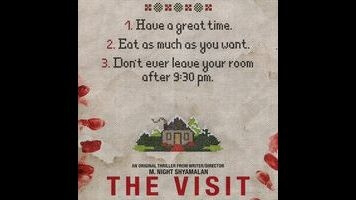M. Night Shyamalan makes a creative comeback with The Visit

“No one cares about cinematic standards.” M. Night Shyamalan, bless his heart, is too artful to commit to the shaky home video look and dead-air pacing of found-footage, and instead comes up with an ingenious workaround, framing The Visit from the perspective of a 15-year-old budding filmmaker as she tries to make a documentary about her creepy grandparents. Self-reflexive and dosed with macabre humor, this offbeat exercise in just-around-the-corner horror grounds the largely exhausted found-footage approach in classical storytelling and visual values, resulting in a refreshing (and memorably strange) genre piece, premised almost entirely on a child’s willingness to accept grown-up weirdness as long as it ensures stability.
Instead of cheating its way out of the motivation problem that plagues most found-footage flicks—“Why are they still filming?”—The Visit puts it front and center, tweaking its own visual style—too spotless to pass for real—in the process. Here, Becca (Olivia DeJonge), teenage and prone to awkward five-dollar word usage, brings along her cameras for a trip out to small-town Pennsylvania, where she and little brother Tyler (Ed Oxenbould) will be spending the week with their long-estranged grandparents (Peter McRobbie, Deanna Dungan). Becca’s goal is simple enough: She wants to get her grandparents to talk about and forgive her mom—who hasn’t seen her folks since leaving home at 19—on camera, in the hope of mending a family broken by decades of resentment and, more recently, a painful divorce.
This is immediately complicated by said grandparents’ bizarre behavior, which ranges from paranoia and forgetfulness to a tendency to crawl around the house naked after dark, scratching at the walls. There’s a basement that can’t be opened and a strict 9:30 p.m. curfew, and whenever Becca tries to get grandma and grandpa to open up, they respond with eerily matter-of-fact stories about invisible monsters and UFOs. Fairy tale imagery abounds: a secluded well, an ax, a house in the woods, Becca’s way of comparing her project to “an elixir,” endless plates of sweets, and an oven that’s just the perfect size for a girl of 15. Shyamalan plays many of the movie’s most unsettling moments for laughs, just as he does Becca’s adolescent artistic ambitions—complete with Barbara Walters-esque interview questions and self-conscious staging—and her awkward attempts at ingratiating herself and Tyler with two people who are, effectively, strangers.
Becca insists on calling the two Nana and Pop Pop, and some of the movie’s best gags come from the characters’ attempts at playing the part of a family, leading to a climax set around a demented, nightmarish game of Yahtzee. (There’s probably a thesis to be written about the way Shyamalan zeroes in on the performative side of family here, with an emphasis on the theatrically artificial lighting of the grandparents’ house.) And though it never matches the elegance and atmosphere of Shyamalan’s best work—partly because the writer-director intentionally deflates the tension with jokes and kid-friendly wisecracks until the third act—the movie’s free-for-all approach to domestic horror still produces plenty of indelible images, framed so that the viewer knows exactly what they’ve seen, but still can’t make sense of what’s going on. Following a creative low period that found the director trying his hand at effects-driven fantasy and sci-fi, it can’t help but come across as a comeback.
For thoughts on, and a place to discuss, the plot details not talked about in this review, visit The Visit’s spoiler space.